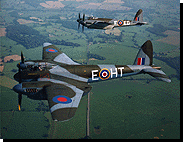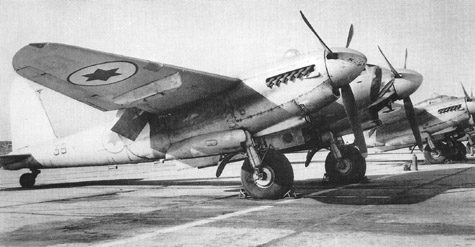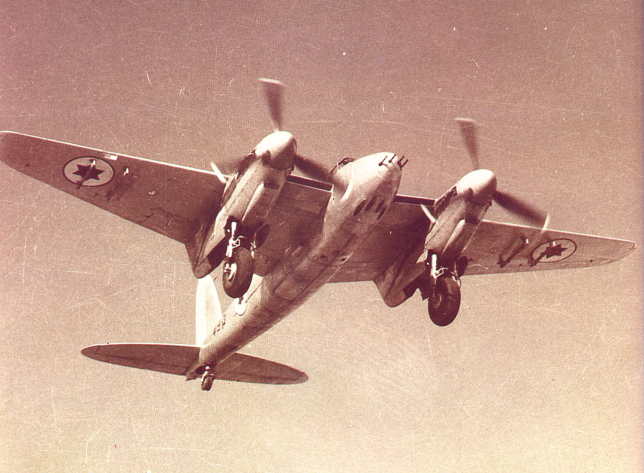de Havilland D.H.98 Mosquito
 The legendary Mosquito, the "Wooden Wonder", was one of the decisive aircraft of World War II. Conceived as an unarmed high-speed bomber similar to the versatile German Junkers Ju 88, the Mosquito was built of a ply/balsa sandwich material. It was first flown on November 25th 1940 and possesed such phenomenal
capabilities that it was developed in many different variants : an unarmed bomber, a reconnaissance aircraft, a radar carrying night fighter
and a potent fighter bomber. Overall production of the Mosquito reached 7,785 examples, the most numerous version being the FB Mk. VI
fighter bomber, 2,584 of which were built. Best known for its RAF service, begun in May 1942, the type has also served with numerous other
air forces including those of Canada and France.
The legendary Mosquito, the "Wooden Wonder", was one of the decisive aircraft of World War II. Conceived as an unarmed high-speed bomber similar to the versatile German Junkers Ju 88, the Mosquito was built of a ply/balsa sandwich material. It was first flown on November 25th 1940 and possesed such phenomenal
capabilities that it was developed in many different variants : an unarmed bomber, a reconnaissance aircraft, a radar carrying night fighter
and a potent fighter bomber. Overall production of the Mosquito reached 7,785 examples, the most numerous version being the FB Mk. VI
fighter bomber, 2,584 of which were built. Best known for its RAF service, begun in May 1942, the type has also served with numerous other
air forces including those of Canada and France.
The first Israeli Mosquito was salvaged from wrecks left by the British in Ekron AFB after the end of the British mandate in early 1948. Despite repeated attempts to repair it, this photo reconnaissance Mosquito PR Mk. XVI could not be returned to flying condition and spent the Israeli War of Independence as a training platfrom for mechanics. It was scrapped in June 1949.
Two more Mosquito PR Mk. XVIs were purchased in England in mid 1948 by Israeli acquisition agents searching for aircraft for the newly born IAF. Only one of these Mosquitoes made it to Israel though, the other destroyed by fire while at an airfield in Corsica, one of its stop-overs on the way to Israel. The surviving
Mosquito was incorporated into the 103rd squadron at Ramat David and was operational for two monthes during which it flew ground attack missions as well as a pair of photo reconnaissance sorties. It crashed on
September 21st 1948 and was returned to service during November. The first operational Mosquito with the IAF, it was also one of the last, retired from service in January 1957 after breaking up upon landing.
On February 17th 1951 a deal was signed between the Israeli and French governments to transfer 67 ex-French Air Force Mosquitoes to the IAF.
The aircraft, bought by the French from the British after the end of World War II and veterans of fighting in French Indo-China, were in
a bad state of repair and the French were glad to be rid of them, selling them at low prices which allowed Israel to buy a large number.
Only on June 11th, after an extensive overhaul, did the aircraft begin arriving in Israel. The new Mosquitoes were of 4 different variants:
- FB Mk. VI - 40 fighter bombers.
- PR Mk. XVI - 4 photo reconnaissance aircraft.
- NF Mk. 30 - 20 night fighters (devoid of their radars).
- TR Mk. 33 - 3 training aircraft.
First located at Ekron (Tel-Nof) AFB, the Mosquitoes quickly moved to Hazor where the 109th Mosquito squadron was formed, comprising of three
sections : operational, training and reconnaissance. A fourth section for night fighting was set up with the arrival of the Mk. 30s in 1952. The large number of aircraft received
exceeded the storage room available at Hazor and the Mosquitoes were parked in the sun. This wrecked havoc on the wooden aircraft and many malfunctioned until shelters were build for the entire Mosquito force. The first flights of the 109th begun in February 1952 with the first reconnaissance missions taking place in
May. These inital flights were conducted over the West Bank and the Sinai and enjoyed only limited success. In August the first Mosquito training course begun, including ground attacks as well as duels against the IAF's primary interceptors of the time, the Spitfire and the Mustang.
On August 23rd 1953 the Mosquito squadron's training section formed a new squadron, the 110th, in charge of training, and a number of Musquitos of each variant were transfered to it.

Mosquito PR Mk.XVI
The mainstay of Mosquito operations before 1956 were reconnaissance missions, using the type's long range and high service ceiling to provide intelligence from as far as Iraq and the Egyptian-Lybian border. The weak performance initially shown during such flights was replaced by better results as the pilots of the 109th gained more experience with the type and the Mosquitoes begun providing the bulk of IAF photographic intelligence. The Mosquitoes routinely overflew Israel's Arab neighbors, photographing Lebanese, Jordanian, Syrian and Egyptian military installations, air bases and army camps.
Although these missions provided and IAF and the IDF with much need intelligence, the IDF's high command had very little confidence in the IAF's reconnaissance capabilities.
Coupled with a fear of provoking retaliation or having its aircraft shot down, it relied more heavily on its ground assests than on the IAF. After repeated requests for more reconnaissance missions were turned down, IAF personnel decided to conduct such missions on their own, without receiving any permission. On September 3rd and 4th 1953 two such missions took place, one over Cairo and the other over the Nile Delta, both carried out by Mosquitoes. The wealth of intelligence provided by these missions convinced the IDF top brass of the advantages in using aerial intelligence, and the number of Mosquito reconnaissance missions was stepped up. In July 1954, as the number of missions flown as well as the depth of their penetration into Arab airspace increased, the photo reconnaissance section of 109th was separated from the squadron and subordinated to Hazor's base commander. In June 1956 the section became the 115th photo reconnaissance squadron at Ekron AFB.
As tension in the Middle East increased in the years leading to the 1956 Suez Crisis and Israel's operation "Kadesh", intelligence gathering was also stepped up. Dozens of missions were flown to map Egyptian air bases, the expected British and French invasion beaches and even the entire Sinai peninsula. Reconnaissance missions continued to take place even after Arab air forces begun arming with jet fighters such as the MiG-15. Despite repeated attempts to intercept the Mosquitoes none were shot done, although 3 of the available 7 PR Mk. XVIs were lost in accidents (three more Mk. XVIs were purchased in Britain in 1956).

The FB Mk. VI, the fighter bomber variant of the Mosquito, was the backbone of the IAF's ground attack force during its years in service. When an Israeli Navy ship run aground near Saudi Arabia in early 1954, Mosquitoes and Mustangs overflew the ship to protect it from Arab forces. The Mk. VI was also involved in a large number of accidents which resulted in 14 Mosquito crew fatalities. On August 8th 1953 a Mosquito was lost during night bombing practice, the pilot apparently suffering from vertigo and crashing into the Mediterranean. Another Mosquito was lost the following day when it hit the sea during the search for the first missing Mosquito. The crashed aircraft were only located in the late 1990s. The accidents usually resulted from poor maintenance of the aircraft, as well as from the havoc wrecked by the Mediterranean weather.
The night fighter Mosquitoes, the NF Mk. 30s, also suffered a great deal from the local weather. Delievered devoid of their radars, these aircraft were fitted with the American APS-4 naval radar and wore a black livery. In 1953 they formed the IAF's first night fighter squadron but the poor performance shown by the new
radars, the poor maintenance and the corrosive local weather hampered their operation. Night fighter operations eventually begun only with the arrival of the Meteor NF.13s in 1955.
Besides the original 3 aircraft, 14 more Mosquito trainers, TR Mk. 33s, were purchased in Britain in 1954. Devoid of their maritime apparatus, such as landing hooks and maritime radars, these aircraft begun leaving for Israel on November 4th 1954.
With advent of jet fighters in the IAF, the piston engined fighter bombers lost their seniority as Israel's frontline aircraft. Hazor AFB became home to jet aircraft and in September 1955 the Mosquitoes were moved to Sirkin and Ekron AFB. In October the two Mosquito squadrons, the 109th and 110th were reunited as the 109th, and in May 1956, in anticipation of the arrival of the Dassault Mystere IVA, the 109th was disbanded and its aircraft sent into storage. The 115th photo reconnaissance squadron however, continued operating the Mosquito with ever greater fervour as tensions were rising in the Middle East. Once the Suez Crisis had broken out in 1956, the Mosquitoes were withdrawn from storage and reformed the 110th squadron at Ramat David, home to all IAF bombers during operation "Kadesh", Israel's part in the war.
The initial planning for operation "Kadesh" called for the IAF to attack Egyptian airfields in anticipation
of an Egyptian attack on Israeli air bases. The Mosquitoes were tasked with attacking the farthest Egyptian airfields, those beyond the Suez Canal such as Cairo-West, Faid and Abu-Sweir. When fighting broke out on
October 29th 1956 however, the only participating Mosquitoes were the PR Mk. XVIs. The planned attack on Egyptian air fields did not take place while propellor driven aircraft were excluded from the battle zones
over the Sinai Desert. Photo reconnaissance missions were flown on October 29th, Egyptian air fields photographed, but only on October 31st did Mosquitoes begin to fly ground attack missions in the Sinai. Mosquitoes were involved in fighting throughout the Sinai, especially in attacks on Egyptian armour and Egyptian army camps. The type was also extensively involved in the fighting around the Egyptian stronghold at Sharm-A-Sheik at the southern tip of the Sinai, attacking the target for 4 consecutive days beginning on
November 1st. In total, 74 Mosquito sorties lasting 141 hours were flown during the operation and 2 aircraft were lost.
The end of operation "Kadesh" also brought about the end of the Mosquito era in the IAF. In January 1957 the 110th squadron was disbanded and the remaining Mosquitoes sent to storage.

Specification: de Havilland Mosquito FB.Mk VI
Type: two-seat long-range fighter bomber.
Powerplant: 2 * Rolls-Royce Merlin 25.
Performance: max speed - 380 mph at sea level, operational range - 1,885 miles.
Weights: empty - 6227kg, max takeoff weight - 10,096kg.
Dimensions: span - 16.51m, length - 12.34m, height - 4.65m.
Armament: 4 * 20mm cannon and 4 * 7.62mm machine guns with 4 * 227kg bombs carried internally and externaly, 8 * 27kg rockets under the wings.
back to Inventory page
my email : skythe@iname.com
 back to the IDF/AF page
back to the IDF/AF page
 The legendary Mosquito, the "Wooden Wonder", was one of the decisive aircraft of World War II. Conceived as an unarmed high-speed bomber similar to the versatile German Junkers Ju 88, the Mosquito was built of a ply/balsa sandwich material. It was first flown on November 25th 1940 and possesed such phenomenal
capabilities that it was developed in many different variants : an unarmed bomber, a reconnaissance aircraft, a radar carrying night fighter
and a potent fighter bomber. Overall production of the Mosquito reached 7,785 examples, the most numerous version being the FB Mk. VI
fighter bomber, 2,584 of which were built. Best known for its RAF service, begun in May 1942, the type has also served with numerous other
air forces including those of Canada and France.
The legendary Mosquito, the "Wooden Wonder", was one of the decisive aircraft of World War II. Conceived as an unarmed high-speed bomber similar to the versatile German Junkers Ju 88, the Mosquito was built of a ply/balsa sandwich material. It was first flown on November 25th 1940 and possesed such phenomenal
capabilities that it was developed in many different variants : an unarmed bomber, a reconnaissance aircraft, a radar carrying night fighter
and a potent fighter bomber. Overall production of the Mosquito reached 7,785 examples, the most numerous version being the FB Mk. VI
fighter bomber, 2,584 of which were built. Best known for its RAF service, begun in May 1942, the type has also served with numerous other
air forces including those of Canada and France.


 back to the IDF/AF page
back to the IDF/AF page